- 1Department of Agronomy, Bahauddin Zakariya University, Multan, Pakistan
- 2Department of Horticulture, Bahauddin Zakariya University, Multan, Pakistan
The present study was conducted to investigate the response of two wheat cultivars (AARI-11 and Millat-11) to a foliar application of four growth enhancers which include: {H2O (water), MLE30 (moringa leaf extract), KCl (potassium chloride), and BAP (benzyl-amino purine)}, within the six irrigation water-regimes which are applied at the various critical growth stages such as crown root initiation (CRI), tillering (T), booting (B), and heading (H). Irrigation water-regimes include: CRI+T+B, CRI+T, CRI+B, T+B, T+H, and control (CRI+T+B+H). The growth enhancers i.e., H2O, MLE30 (1:30), KCl (2%), and BAP (50 mg L−1) were applied @ 500 L ha−1 at tillering and heading stages. The results demonstrated some increased quantities of both enzymatic (superoxide dismutase, peroxidase, catalase) and non-enzymatic (ascorbic acid, phenol) antioxidants in leaves of AARI-11 when MLE30 was applied under T+B and T+H irrigation water-regimes. Similar results were also observed in the case of leaf chlorophyll “a” and “b” and K+ contents in both cultivars under control, T+B and CRI+T+B irrigation water regimes. AARI-11 produced the highest biological and grain yield, due to the application of MLE30 and BAP under control, CRI+T+B, T+B, and T+H irrigation water-regimes. However, KCl lagged behind among the treatments set for both cultivars under all the irrigation water-regimes. Foliar spray of MLE30 remained prominent growth enhancer and stresses mitigating agent under water deficit conditions particularly under T+B and T+H irrigation water-regimes. Moreover, economic analysis indicated that the foliar application of MLE30 is a cost effective and environment friendly strategy for the maximum yield and income.
Introduction
Wheat (Triticum aestivum L.) is one of the most important feeding cereals for one-fifth of the world population (FAO, 2011). Therefore, wheat crops require a special attention for an incremental production in order to ease the food security issues for the world population which is growing so rapidly. Today, Wheat plants are facing oxidative damage at cellular level which reduces leaf surface area, crop growth rate, net assimilation rate, leaf chlorophyll and nutrient contents in grains due to insufficient availability of water (Araus et al., 2003). For mitigating oxidative stress, application of irrigations at vegetative and reproductive growth stages is a sensitive tool for obtaining optimum yields. Irrigation water-regimes at the critical growth stages of wheat minimize severe losses of grain yield as at pre-anthesis (1–30%) and post-anthesis (58–92%) stages (Farooq et al., 2014). Hence, to determine the most critical growth stages of wheat for irrigation management and utilization of available water resources is necessary to maximize crop yield.
The behavior of plants in surviving and producing good yield under limited water stress is called drought tolerance (Turner, 1979). Plants' tolerance against environmental stresses can be increased by the exogenous application of certain growth enhancers like proline, amino acids, ABA, glycine betaine, BAP, silicon, soluble sugars, humic acid, and potassium (Farooq et al., 2009). Appropriate concentrations of these synthetic enhancers could promote the growth of plants and ameliorate water deficit stress by interfering in metabolic and photosynthesis processes through osmotic adjustment, scavenging ROS, increasing enzymatic and non-enzymatic antioxidants and proteins (Bohnert and Jensen, 1996). Exogenous foliar spray of growth enhancers at the critical growth stages of wheat (tillering, booting, heading, milking), is one of the most significant parts which increase antioxidants status against reactive oxygen species under water deficit condition (Yasmeen et al., 2012). Whereas, using these synthetic growth enhancers like BAP or KCl may cause various drastic effects on wheat grain quality, the consumers' health and benefit cost ratio. However, the applications of naturally occurring growth enhancers like moringa leaf extract (MLE) can be environment friendly and economically feasible. Moringa (Moringa oleifera) is a well-known native tree of southern Punjab (Pakistan) and has proved as an excellent growth enhancer containing K, Ca, Fe, amino acids, ascorbates, and growth regulating hormones such as zeatin (Fuglie, 2000). Yasmeen et al. (2012) screened out the positive impact of MLE at various critical growth stages of wheat under saline stress in control conditions (laboratory) and suggested the best application time at tillering and heading. The responses of MLE application to ameliorate drought impacts in wheat at critical growth stages have not been well established yet. Therefore, the present study was conducted to evaluate the performance of MLE as an organically natural plant growth enhancer in comparison with BAP and KCl for improving the productivity of wheat under various irrigation water-regimes at the critical growth stages.
Materials and Methods
The experiments were conducted at the Agronomic Experimental Area, Bahauddin Zakariya University Multan (71.43°E, 30.2°N and 122 m above sea level), Pakistan, during the winter seasons of 2013–2014 and 2014–2015. The region is located in semi-arid and sub-tropical climate and data of mean annual temperature. An average rainfall and relative humanity, during the both years of crop growing period is presented in Figure 1. The soil belongs to Sindhlianwali soil series (fine silty, mixed, hyperthermic, sodic haplocambids) in USDA Hap-lic Yermosols in FAO classification. It was characterized after analyzing the samples taken from different locations of the experimental site. Soil was clay loam having ECe 2.42 dS m−1 and pH 8.7, organic matter 0.83–0.88%, total nitrogen 0.05–0.06%, available phosphorus 5.50–5.54 mg kg−1, available potassium 300–303 mg kg−1 and zinc 0.36–0.39 mg kg−1 during both years of trials. The trial comprised two wheat cultivars AARI-11 (drought tolerant) and Millat-11 (drought sensitive; Nawaz et al., 2015). Six irrigation water-regimes were adopted based on the critical growth stages of wheat {Crown Root Initiation (CRI), Tillering (T), Booting (B), and Heading (H) stages} i.e., irrigations applied at CRI+T+B+H (control), irrigations applied at CRI+T+B, irrigations applied at CRI+B, irrigations applied at CRI+H, irrigations applied at T+B and irrigations applied at T+H. The Foliar Application of four growth enhancers i.e. H2O (control), MLE30 (1:30), KCl (2%), BAP (50 mg L−1) @ 500 L ha−1 were applied using garden sprayer (Flat Fan Nozzle). The response of wheat plants to the application of growth enhancers under drought stress or the effect of the growth enhancers on the planted wheat was recorded by measuring growth, yield and biochemical parameters in both the cultivars.
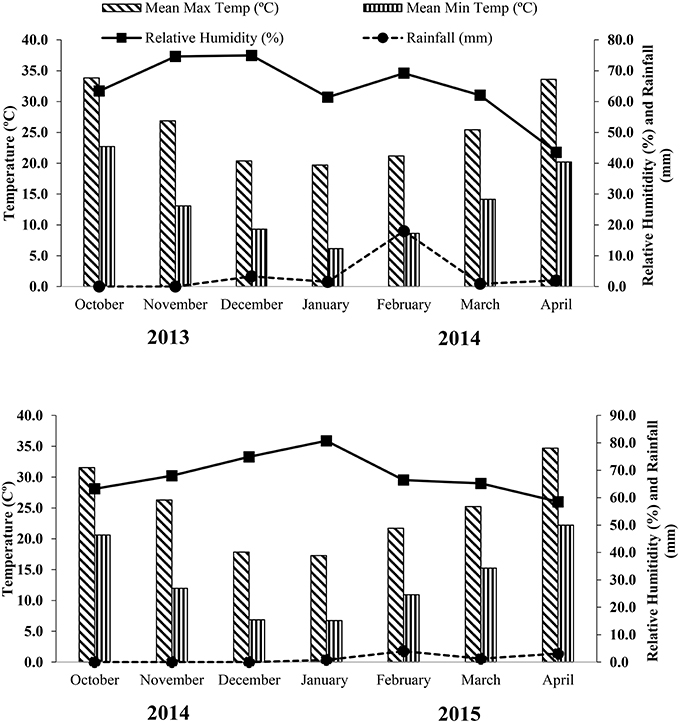
Figure 1. Meteorological data for growing period of wheat crop during the years 2013-2014 and 2014-2015.
The procedure described by Yasmeen et al. (2012) for the preparation of moringa leaf extract, was followed. Fresh young leaves were collected from moringa trees grown in the Experimental Area of Faculty of Agricultural Sciences and Technology, Bahauddin Zakariya University Multan, Pakistan and stored in a freezer at −80°C. The leaves were crushed through locally available juicer machine; the extract was purified by centrifuging at 8000 rpm for 20 min and diluted 30 times by adding distilled water. Foliar spray of growth enhancers H2O, MLE30, KCl, and BAP was were applied at the tillering and heading stages of the wheat cultivars.
Pre-soaking irrigation of 10 cm depth was applied on the soil to prepare the favorable seedbed conditions for the experiment. After observing the soil at a workable moisture level, it was plowed twice, followed by planting. The seed rate was 125 kg ha−1 and NPK applied at 120-100-62.5 kg ha−1 by using fertilizers urea, single super phosphate and potassium sulfate, respectively. Whole recommended phosphorus, potash and one-third of nitrogen were applied as basal dose and the remaining nitrogen was applied in two splits during the growing period of wheat crop. During both years of trial, slight rains in the growing period occurred but its intensity was not enough to change the soil moisture level under applied water deficit stress condition at the critical growth stages. Intercultural practices and crop protection measures were practiced as per requirement of the crop uniformly for all experimental plots.
Flag leave samples were collected randomly in the morning time (temp. 20 ± 2°C) and stored in polythene bags at −80°C for antioxidants analysis after just 1 week of the last irrigation and foliar application of growth enhancers at the heading stage. The protocol devised by Bradford (1976) was applied to quantify the total soluble proteins (TSP). For determination of endogenous enzymatic and non-enzymatic antioxidants, standard protocols were adopted to measure peroxidase (POD), catalase (CAT) (Chance and Maehly, 1955), superoxide dismutase (SOD) (Giannopolitis and Reis, 1997), ascorbic acid (AsA) (Ainsworth and Gillespie, 2007), and total phenolic contents (TPC) (Waterhouse, 2001). Leaf chlorophyll (“a” and “b”) (Nagata and Yamashita, 1992) and potassium (K+) contents (Rashid, 1986) were determined as per given standard procedures. The number of the productive tillers (m−2) and the number of grains per spike and 1000-grain weight were also recorded. The mature crop was harvested on the 1st and 2nd fortnight of April during the first and second years of the trail respectively, and threshed manually to determine grain yield, biological yield, and harvest index.
The total expenditures of the wheat production were calculated including land rent, seedbed preparation, seed cost, sowing labor, fertilizers, irrigations, weeds preventive measures and harvesting charges of the crops for economic analysis. Gross income was calculated using recent market prices of wheat grains and straw. Net income was obtained by subtracting the total expenditures from gross income and benefit cost-ratio estimated at a ratio of gross income and total expenditures. Data were computed and analyzed statistically using Fisher's analysis of variance technique and LSD test (p < 0.05) to compare differences among the mean values (Steel et al., 1997). Moreover, Microsoft Excel Program 2013 was used for the graphical presentation of meteorological data.
Results
Antioxidants Activities
Application of the growth stimulators significantly enhanced the TSP during imposed water deficit stressed levels. However, MLE30 and BAP sprays were more effective in this regard during the both years of study. The maximum TSP was obtained from the foliar application of MLE30 in Millat-11 under irrigation water-regimes of T+B and T+H (Table 1). The effect of exogenously applied stimulators on antioxidants status was found statistically significant (Tables 1, 2). The contents of enzymatic and non-enzymatic antioxidants were increased with the imposition of water deficit stress at the critical growth stages in both wheat cultivars. Among the treatments, MLE30 and BAP application revealed maximum enzymatic activities i.e. SOD, POD, and CAT under irrigated water-regimes of T+B, T+H, and CRI+T respectively, in AARI-11 as compared to Millat-11 during the both years (Tables 1, 2). Irrigation at T+B stages showed a dominant and gradual rise in AsA content in flag leaf of wheat. The maximum contents of AsA (non-enzymatic antioxidants) were observed due to foliar application of MLE30 under all irrigation water-regimes in both cultivars during the both years of trial (Table 2). However, increased content of TPC was obtained under applied irrigations at T+B and T+H stages from applied treatment of MLE30, followed by BAP and KCl in AARI-11 during the both years (Table 2).
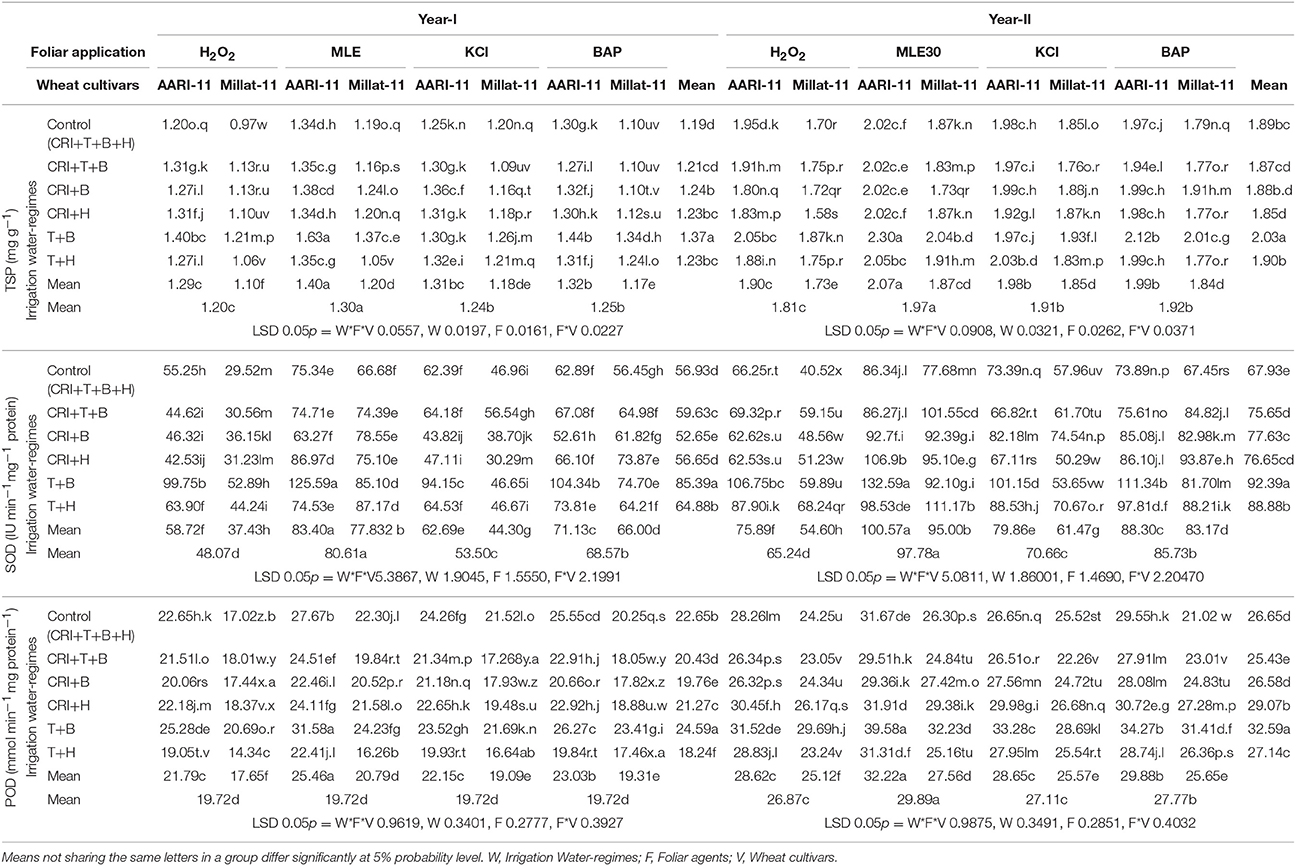
Table 1. Influence of different foliar agents on total soluble protein (TSP), superoxide Dismutase (SOD) and peroxidase (POD) of wheat cultivars under various applied irrigation water-regimes during 2013-2014 (Year-I) and 2014-2015 (Year-II).
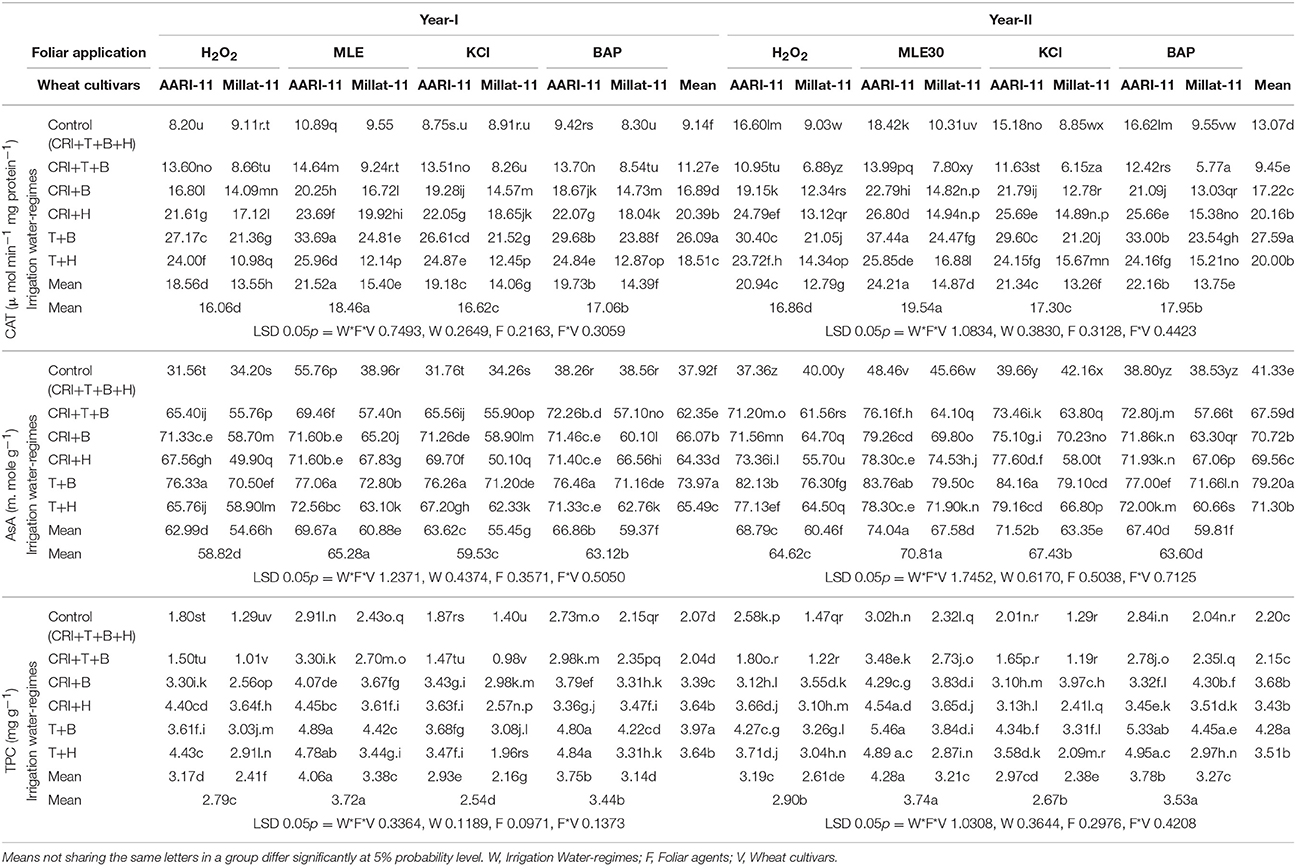
Table 2. Influence of different foliar agents on catalase (CAT), ascorbic acid (AsA) and total phenolic contents (TPC) of wheat cultivars under various applied irrigation water-regimes during 2013-2014 (Year-I) and 2014-2015 (Year-II).
Leaf Chlorophyll Contents
Chlorophyll contents “a” and “b” were found significantly higher, due to foliar application of MLE30 and BAP under applied irrigation regimes of control, T+ B and T+H stages in AARI-11 during the both years of study (Table 3). The results also illustrated that the chlorophyll contents “a” and “b” decreased in Millat-11 under all irrigation water-regimes but due to the foliar application of MLE30 and BAP, their levels were maintained (Table 3).
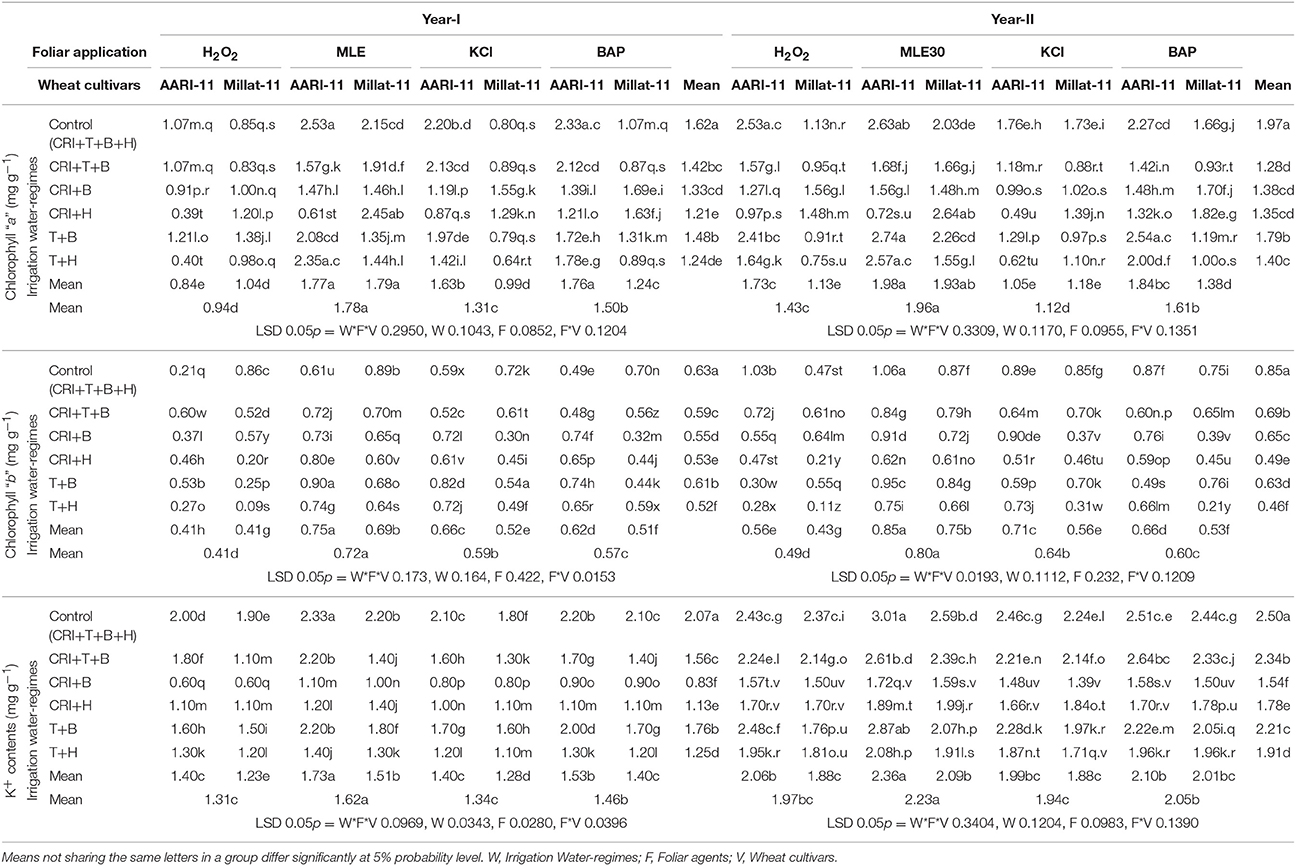
Table 3. Influence of different foliar agents on chlorophyll “a & b” and K+ contents of wheat cultivars under various applied irrigation water-regimes during 2013-2014 (Year-I) and 2014-2015 (Year-II).
Leaf K+ Content
The MLE30 application increased leaf K+ content under imposed irrigation water-regimes, but the maximum leaf K+ content was observed in AARI-11 plants under the applied irrigation water-regimes of control, CRI+T+B and T+B respectively, in the both years. The least K+ contents were observed under the irrigation water-regimes applied at CRI+T, CRI+B, and CRI+H stages in both cultivars during the both years of trial (Table 3).
Yield and Yield Components
Foliar applications, irrigation water-regimes and wheat cultivars significantly affected the number of fertile tillers (Table 4). Results demonstrated that the application of MLE30 and BAP with irrigation water-regimes of CRI+T+B+H, CRI+T+B, and T+B resulted in the maximum fertile tillers in AARI-11 during the both growing years. The minimum number of fertile tillers was observed when irrigations were applied at CRI+B and T+H stages in both cultivars during the year-I but fertile tillers increased by the application of growth stimulators during the year-II, even though the irrigations were applied at CRI+B and T+H stages (Table 4). Results revealed that the number of grains per spike with the irrigation water-regimes at control, CRI+T+B and T+B stages were non-significant in both cultivars. Among the foliar sprays, performance of MLE30 was better than BAP, KCl, and H2O and produced the maximum number of grains per spike in both cultivars under all irrigation water-regimes (Table 4). Foliar growth agents under the applied irrigations at CRI+T+B+H, T+B, T+H critical growth stages in the studied wheat cultivars significantly affected yield components (Table 5). The results depicted that 1000-grain weight in AARI-11 was the maximum under the applied irrigation water-regimes of control, followed by T+B and T+H especially by MLE30 treatment during the both years of study. Yield parameters i.e. grain yield, biological yield and harvest index clearly demonstrated significant results among the wheat cultivars grown under various irrigation water-regimes (Table 5). Among the growth stimulators, MLE30 and BAP applied to AARI-11, resulted in the maximum grain yield and harvest index when the irrigations were applied at CRI+T+B+H, CRI+T+B, and T+B stages during the both years. Harvest index of wheat cultivars during the both years of trial at the applied irrigation water-regimes of control and T+B was the maximum due to the application of MLE30 (Table 5).
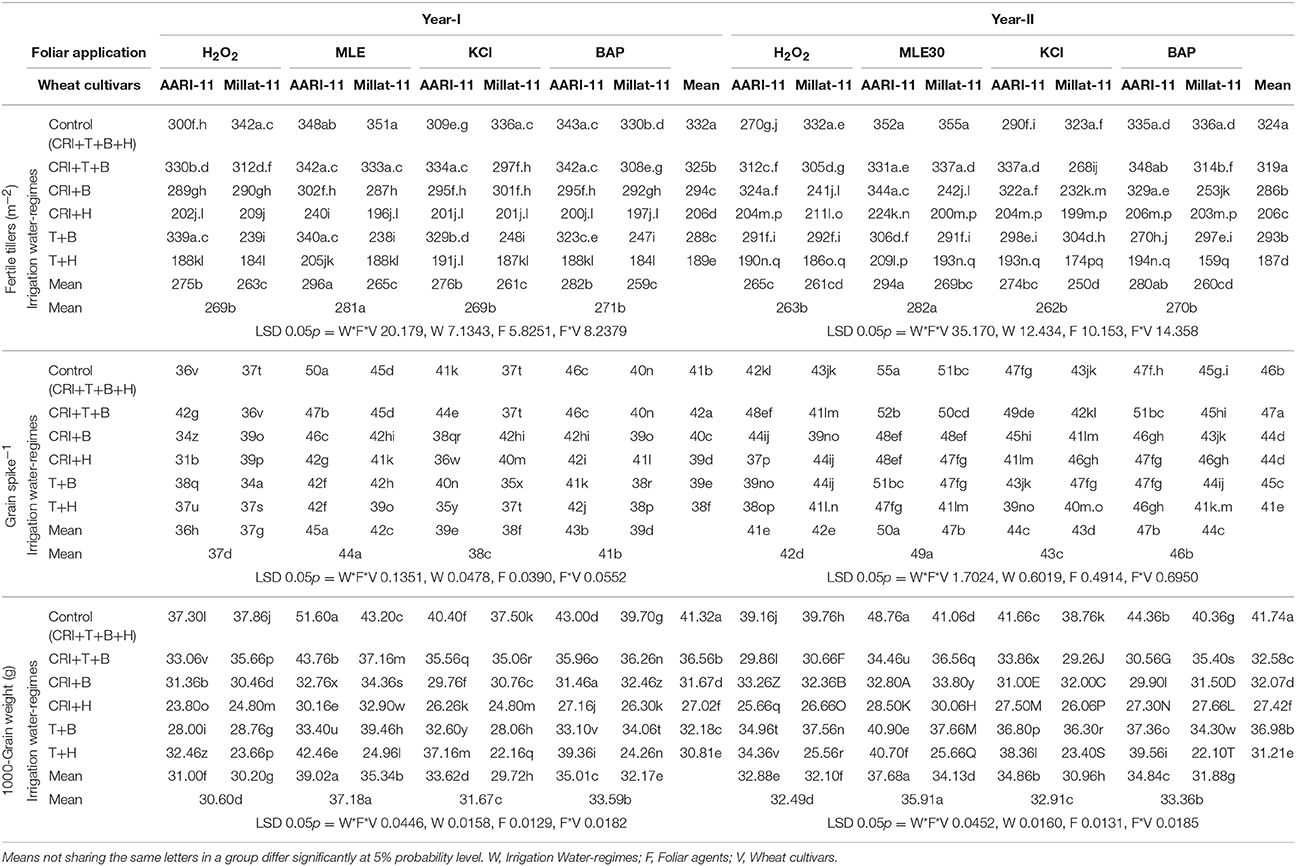
Table 4. Influence of different foliar agents on fertile tillers (m−2), grain Spike−1 and 1000 grain weight (g) of wheat cultivars under applied irrigation water-regimes during 2013-2014 (Year-I) and 2014-2015 (Year-II).
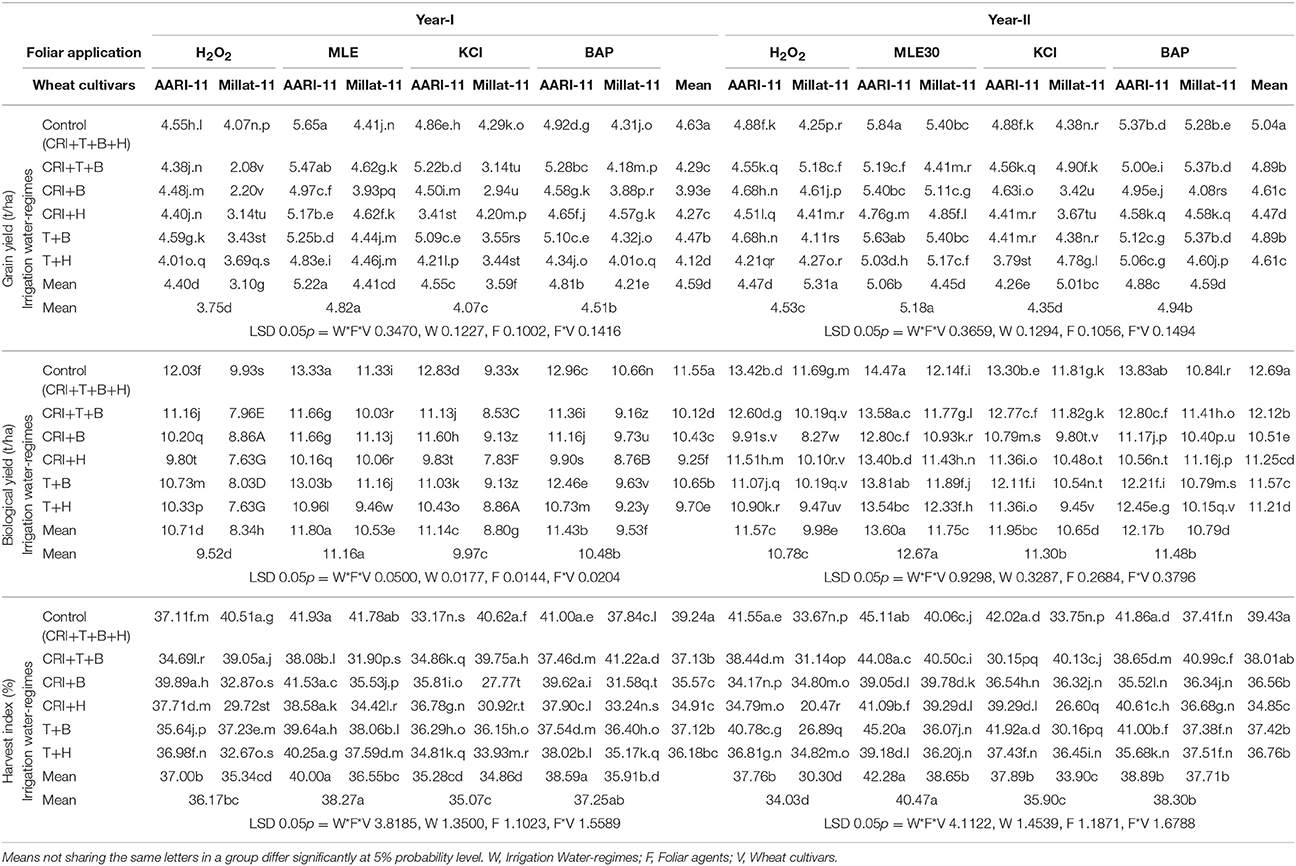
Table 5. Influence of different Foliar agents on grain yield (t/ha), biological yield (t/ha) and harvest index (%) of wheat cultivars under applied irrigation water-regimes during 2013-2014 (Year-I) and 2014-2015 (Year-II).
Benefit Cost Ratio
Economic analysis showed that the MLE30 foliar application was comparatively the most cost effective technology to obtain the maximum benefit cost ratio (BCR) with irrigation water-regimes of CRI+T and T+B after control (Table 6).
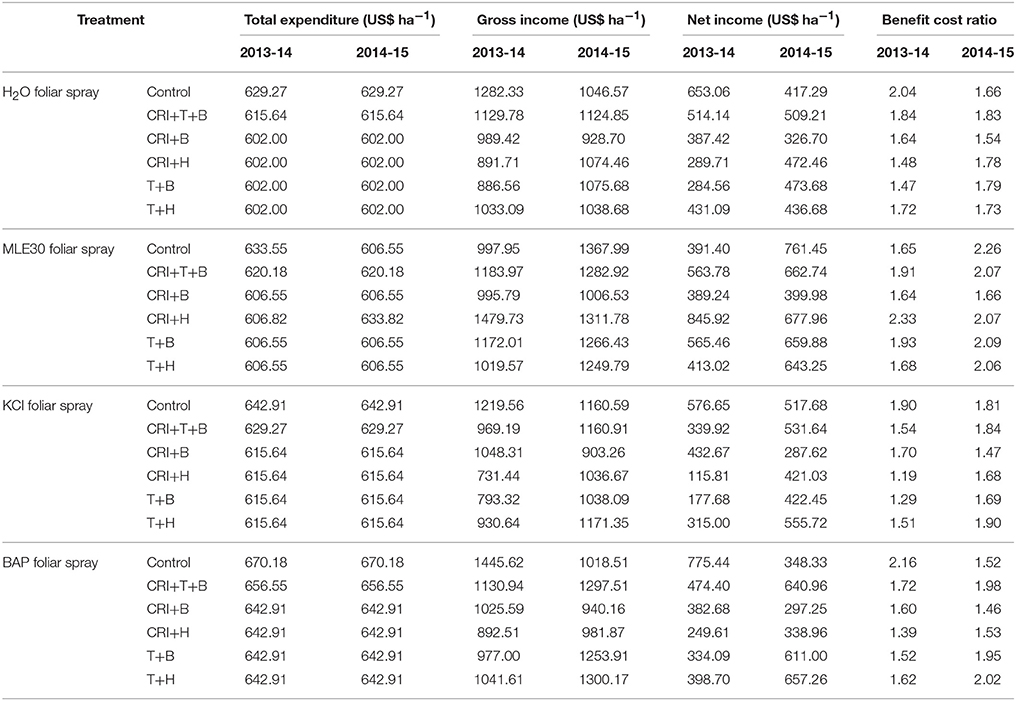
Table 6. Economic analysis (average of both cultivars) for the impact of foliar spray under various irrigation water-regimes at the critical growth stages of wheat.
Discussion
Oxidative stress under water deficit conditions is characterized as an imbalance between production of ROS and quenching activity of antioxidant system which possesses a serious threat to plant cellular membranes and other cellular organelles like proteins, DNA, etc. (White et al., 1993). The ability of plant to scavenge toxic/active ionic forms of oxygen radicles has seemed to be an important consideration of its tolerance to environmental stresses including water deficit stress. Plant antioxidants defense system including enzymatic (SOD, CAT, POD) and non-enzymatic (AsA, TPC) ones has been proved a possible protective measure against oxidative damages by inhibiting release of ROS (Mittler, 2002). The present study demonstrated that increased contents of antioxidants (enzymatic and non-enzymatic) by foliar application of growth enhancers especially MLE30 and BAP at various sensitive growth stages of wheat cultivars under water deficit conditions, is the most effective strategy. Exogenous applications of MLE30, BAP, KCl and H2O to AARI-11 plants helped in ameliorating the water stress effects during the water deficit conditions and motivated the enzymatic antioxidants defense system to maintain its ionic homeostasis status. The maximum release of SOD, POD, CAT enzymatic contents due to the application of MLE30 and BAP probably has the ability to mitigate the effect of water stress during the applied irrigation water-regimes at T+B and T+H stages of AARI-11 plants (Farooq et al., 2009). On the other hand, non-enzymatic antioxidants (AsA) played crucial role in scavenging ROS and triggering the antioxidant defensive system against water deficit stress in wheat plants. The foliar application with MLE30 and BAP enhanced the production of AsA which increased the plant tolerance and improved photosynthetic activity in AARI-11 cultivar under irrigation water-regimes at T+B and T+H stages (Hanaa et al., 2008). The foliar application of MLE30 played an important role in protective measures against oxidative damage stress in wheat cultivar AARI-11 and enhanced the activities of TPC under irrigation water-regimes of T+B and T+H during the both years. The ability of MLE30 foliar agent to initiate the positive release of antioxidants is due to the presence of zeatin in it, which reduced the water stress and also promoted leaf chlorophyll contents “a” and “b” that has a vital role in photosynthesis process (Foidle et al., 2001).
Crop yield is based on chlorophyll contents and photosynthesis rate during the normal environmental conditions. The present study described that increased chlorophyll contents “a” and “b” in AARI-11 plants were due to their larger leaf area, and exogenous application of growth enhancer facilitated the photosynthetic rate under water deficit conditions especially at irrigation water-regimes of T+B after control and CRI+T+B stages, respectively (Ali et al., 2011). Similarly, Yasmeen et al. (2013) reported significance of MLE30 as moringa leaves contain a heavy amount of mineral contents including K+ which is an excellent plant growth enhancer/regulator. Leaf K+ content in AARI-11 plants with the application of MLE30 and BAP attributed direct increase in the K+ content which ultimately enhanced the uptake of K+ during the stomatal conductance (Cakmak, 2005).
Wheat yield depends on numbers of fertile/productive tillers and grain weight at harvest. The maximum production of fertile tiller in AARI-11 was due to its greater tolerance against water deficit stress and in addition to foliar application, of MLE30 and BAP at tillering and heading stages which resulted in increased number of grains per spike and 1000-grain weight under control, followed by T+H and T+B irrigation water-regimes (Baque et al., 2006). Biological yield was significantly prominent in AARI-11 plants. It might be possible that the foliar application of MLE30 and BAP at heading stage mitigated the water scarcity impact in wheat which increased grain yield not only in control, but also in T+B and T+H irrigation water-regimes (Yasmeen et al., 2012). Tillering and heading are the most important stages for the foliar application of growth regulators. At the tillering stage, MLE30 promoted the booting and similarly at the heading stages enhanced the grain filling and milking which led to increased biological yield and grain yield (Farooq et al., 2014). The foliar application also increased the harvest index (HI) during the both years, but MLE30 growth stimulator gave the maximum HI possibly due to its role in dry matter accumulation under various irrigation water-regimes i.e. control, CRI+T+B, T+B, and T+H, respectively, (Madani et al., 2010). Economic analysis illustrated that foliar application of MLE30 was a cost effective strategy for an increased benefit cost ratio of wheat.
Conclusion
The foliar application of naturally occurring MLE30 growth enhancer at the tillering and heading stages of wheat cv. AARI-11 ameliorated the water deficit stress by enhancing the antioxidants contents to protect it against oxidative damage which modulated yield related components under irrigation water-regimes at T+B and T+H over control (CRI+T+B+H).
Future Research Needs
Mechanism of photosynthetic product distribution and assimilation needs to be investigated after MLE application.
Author Contributions
NH Supervisor Helped in supervised the research project and guide in conducting the research in the Field. HN student, performed all the activities during the research including research planning, lab analysis, write up. AY Co-supervisor, helped in lab analysis and data analysis. MA Help in review the article and guide in improving the article.
Conflict of Interest Statement
The authors declare that the research was conducted in the absence of any commercial or financial relationships that could be construed as a potential conflict of interest.
Acknowledgments
The authors are grateful to “Bahauddin Zakariya University Multan, Pakistan” for financial support for this study through research project No. MRO/D-108 titled “Improvement in growth, yield and antioxidant status of wheat with exogenous application of growth enhancer under drought stress condition.”
Abbreviations
AsA, ascorbic acid; BAP, benzyl-amino purine; B, booting; BCR, benefit cost ratio; CRI, crown root initiation; Chl., chlorophyll; CAT, catalase; H, heading; MLE, moringa leaf extract; POD, peroxidase; ROS, reactive oxygen species; SOD, superoxide dismutase; T, tillering; TPC, total phenolic contents; TSP, total soluble proteins.
References
Ainsworth, E. A., and Gillespie, K. M. (2007). Estimation of total phenolic content and other oxidation substrates in plant tissues using Folin-Ciocalteu reagent. Nat. Prot. 2, 875–877. doi: 10.1038/nprot.2007.102
Ali, Z., Basra, S. M. A., Munir, H., Mahmood, A., and Yousaf, S. (2011). Mitigation of drought stress in maize by natural and synthetic growth promoters. J. Agric. Soc. Sci. 7, 56–62.
Araus, J. L., Bort, J., Steduto, P., Villegas, D., and Royo, C. (2003). Breeding cereals for Mediterranean conditions: ecophysiology clues for biotechnology application. Ann. Appl. Biol. 142, 129–141. doi: 10.1111/j.1744-7348.2003.tb00238.x
Baque, M. A., Karim, M. A., Hamid, A., and Tetsushi, H. (2006). Effect of fertilizer potassium on growth, yield and nutrient uptake of wheat (Triticum aestivum) under water stress conditions. South Pacific Stud. 27, 25–36. Available online at: http://cpi.kagoshima-u.ac.jp/publications/southpacificstudies/sps/sps27-1/SouthPacificStudies27(1)pp25-35.pdf
Bohnert, H. J., and Jensen, R. G. (1996). Strategies for engineering water stress tolerance in plants. Trends Biotechnol. 14, 89–97. doi: 10.1016/0167-7799(96)80929-2
Bradford, M. (1976). A rapid and sensitive method for the quantitation of microgram quantities of protein utilizing the principle of protein-dye binding. Ann. Biochem. 72, 248–254.
Cakmak, I. (2005). The role of potassium in alleviating detrimental effects of abiotic stresses in plants. J. Plant Nutr. Soil Sci. 168, 521–530. doi: 10.1002/jpln.200420485
FAO (2011). Crop Prospects and Food Situation. Rome: Food and Agriculture Organization the United Nations, Global Information and Early Warning System, Trade and Markets Division (EST).
Farooq, M., Hussain, M., and Siddique, K. H. M. (2014). Drought stress in wheat during flowering and grain-filling periods. Crit. Rev. Plant Sci. 33, 331–349. doi: 10.1080/07352689.2014.875291
Farooq, M., Wahid, A., Kobayashi, N., Fujita, D., and Basra, S. M. A. (2009). Plant drought stress: effects, mechanisms and management. Agron. Sustain. Dev. 29, 185–212. doi: 10.1051/agro:2008021
Foidle, N., Makkar, H. P. S., and Becker, K. (2001). “The potential of Moringa oleifera for agricultural and industrial uses,” in The Miracle Tree: The Multipurpose Attributes of Moringa, ed L. Fugile (Wageningen: CTA Publications), 45–76.
Fuglie, L. J. (2000). New uses of moringa studied in nicaragua. ECHO Dev. 68. Available online at: http://www.map-abcdf.com.ph/documents/submitted%20papers/NEW%20USES%20OF%20MORINGA%20STUDIED%20IN%20NICARAGUA.pdf
Giannopolitis, C. N., and Reis, S. K. (1997). Superoxide dismutase I. Occurrence in higher plants. Plant Physiol. 59, 309–314.
Hanaa, H., El-Baky, A., Hussein, M. M., and El-Baroty, G. S. (2008). Algal extracts improve antioxidant defense abilities and salt tolerance of wheat plant irrigated with sea water. Afr. J. Biochem. Res. 7, 151–164. Available online at: http://www.academicjournals.org/journal/AJBR/article-abstract/82070DD10085
Madani, A., Rad, A. S., Pazoki, A., Nourmohammadi, G., and Zarghami, R. (2010). Wheat (Triticum aestivum L.) grain filling and dry matter partitioning responses to source: sink modifications under post-anthesis water and nitrogen deficiency. Acta. Sci. Agron. 32, 145–151. doi: 10.4025/actasciagron.v32i1.6273
Mittler, R. (2002). Oxidative stress, antioxidant and stress tolerance: a review. Trends Plant Sci. 7, 405–410. doi: 10.1016/S1360-1385(02)02312-9
Nagata, M., and Yamashita, I. (1992). Simple method for simultaneous determination of chlorophyll and carotenoids in tomato fruit. J. Jpn. Soc. Food Sci. Technol. 39, 925–928.
Nawaz, H., Hussain, N., and Yasmeen, A. (2015). Growth, yield and antioxidants status of wheat (Triticum aestivum L.) cultivars under water deficit conditions. Pak. J. Agri. Sci. 52, 953–959. Available online at: http://www.pakjas.com.pk/papers/2504.pdf
Rashid, A. (1986). Mapping Zinc Fertility of Soils Using Indicator Plants and Soils-Analyses. Ph.D. Dissertation, University of Hawaii, HI, USA.
Steel, R. C. D., Torrie, J. H., and Deekey, D. A. (1997). Principles and Procedures of Statistics a Biometric Approach, 3rd Edn. New York, NY: McGraw Hill Book Co. Inc., 400–428.
Turner, N. C. (1979). “Drought resistance and adaptation to water deficits in crop plants,” in Stress Physiology in Crop Plants, eds H. Mussell and C. R. Staples (New York, NY: John Wiley and Sons), 343–372.
Waterhouse, A. L. (2001). “Determination of total phenolics,” in Current Protocols in Food Analytical Chemistry, ed R. E. Wrolstad (New York, NY: John Wiley and Sons), 11.1.1–11.1.8.
White, R. H., Bruneau, A. H., and Cowett, T. J. (1993). “Drought resistance of diverse tall fescue cultivars,” in International Turfgrass Society Research Journal, Vol. 7, eds R. W. Carrow, N. E. Christian, and R. C. Shearman (Overland: Interec Publishing Corporation), 607–613.
Yasmeen, A., Basra, S. M. A., Ahmad, R., and Wahid, A. (2012). Performance of late sown wheat in response to foliar application of Moringa oleifera Lam. leaf extract. Chil. J. Agric. Res. 72, 92–97. doi: 10.4067/S0718-58392012000100015
Keywords: enzymes, non-enzymes, benefit cost ratio, growth regulators, irrigation water-regimes
Citation: Nawaz H, Yasmeen A, Anjum MA and Hussain N (2016) Exogenous Application of Growth Enhancers Mitigate Water Stress in Wheat by Antioxidant Elevation. Front. Plant Sci. 7:597. doi: 10.3389/fpls.2016.00597
Received: 09 January 2016; Accepted: 18 April 2016;
Published: 04 May 2016.
Edited by:
Mohammad Anwar Hossain, Bangladesh Agricultural University, BangladeshReviewed by:
Cándido López-Castañeda, Colegio de Postgraduados, MexicoRanjeet Ranjan Kumar, Indian Agricultural Research Institute, India
Wanping Fang, Nanjing Agricultural University, China
Copyright © 2016 Nawaz, Yasmeen, Anjum and Hussain. This is an open-access article distributed under the terms of the Creative Commons Attribution License (CC BY). The use, distribution or reproduction in other forums is permitted, provided the original author(s) or licensor are credited and that the original publication in this journal is cited, in accordance with accepted academic practice. No use, distribution or reproduction is permitted which does not comply with these terms.
*Correspondence: Nazim Hussain, nazimhussain@bzu.edu.pk
 Hamid Nawaz
Hamid Nawaz Azra Yasmeen1
Azra Yasmeen1 Nazim Hussain
Nazim Hussain